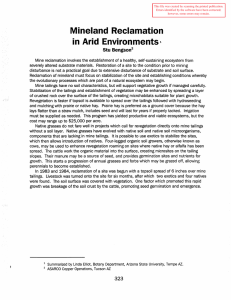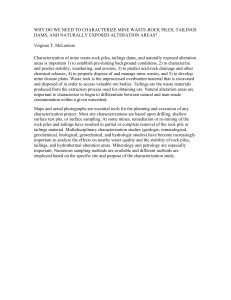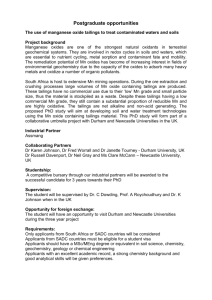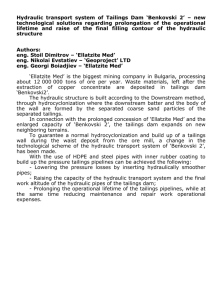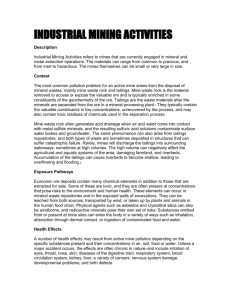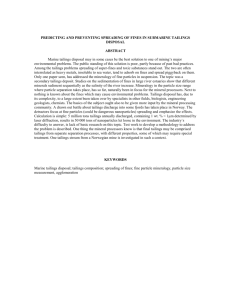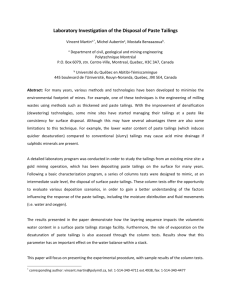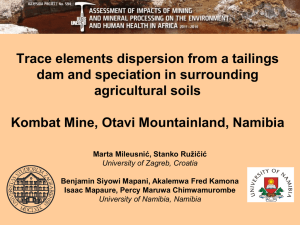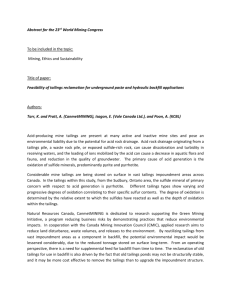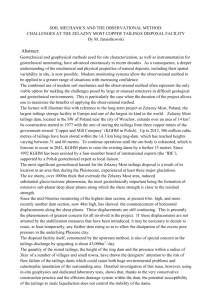Document 11871749
advertisement
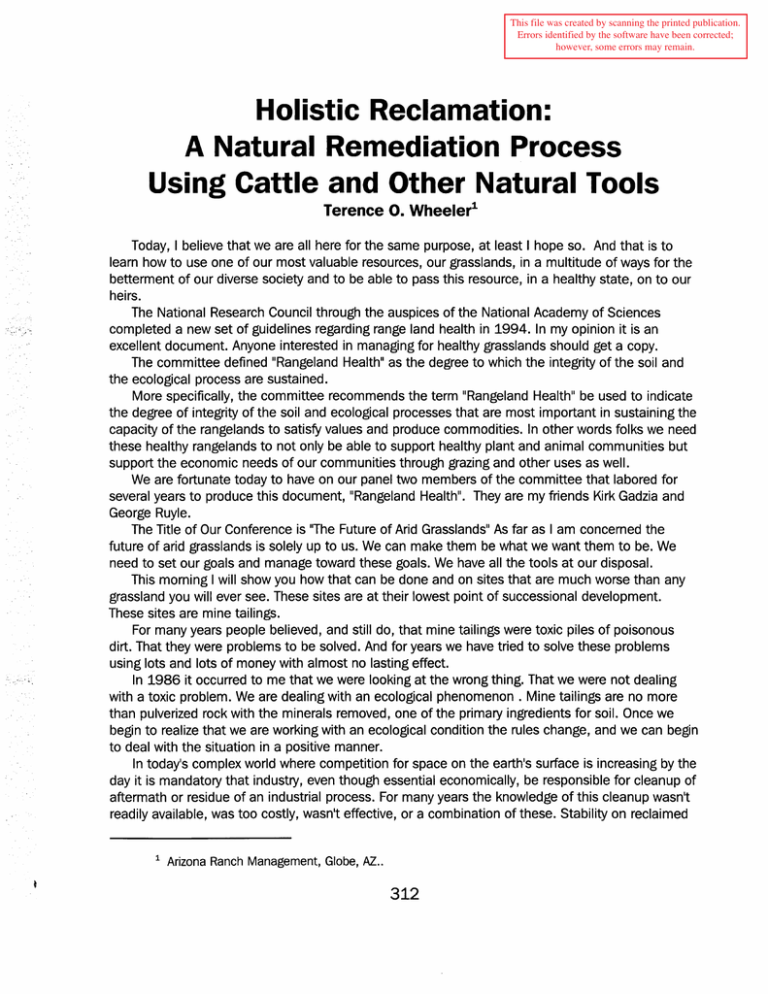
This file was created by scanning the printed publication. Errors identified by the software have been corrected; however, some errors may remain. Holistic Reclamation: A Natural Remediation Process Using Cattle and Other Natural Tools Terence 0. Wheeler1 Today, I believe that we are all here for the same purpose, at least I hope so. And that is to learn how to use one of our most valuable resources, our grasslands, in a multitude of ways for the betterment of our diverse society and to be able to pass this resource, in a healthy state, on to our heirs. The National Research Council through the auspices of the National Academy of Sciences completed a new set of guidelines regarding range land health in 1994. In my opinion it is an excellent document. Anyone interested in managing for healthy grasslands should get a copy. The committee defined 11 Rangeland Health 11 as the degree to which the integrity of the soil and the ecological process are sustained. More specifically, the committee recommends the term 11 Rangeland Health 11 be used to indicate the degree of integrity of the soil and ecological processes that are most important in sustaining the capacity of the rangelands to satisfy values and produce commodities. In other words folks we need these healthy rangelands to not only be able to support healthy plant and animal communities but support the economic needs of our communities through grazing and other uses as well. We are fortunate today to have on our panel two members of the committee that labored for several years to produce this document, ~~Rangeland Health 11 • They are my friends Kirk Gadzia and George Ruyle. The Title of Our Conference is 11The Future of Arid Grasslands11 As far as I am concerned the future of arid grasslands is solely up to us. We can make them be what we want them to be. We need to set our goals and manage toward these goals. We have all the tools at our disposal. This morning I will show you how that can be done and on sites that are much worse than any grassland you will ever see. These sites are at their lowest point of successional development. These sites are mine tailings. For many years people believed, and still do, that mine tailings were toxic piles of poisonous dirt. That they were problems to be solved. And for years we have tried to solve these problems using lots and lots of money with almost no lasting effect. In 1986 it occurred to me that we were looking at the wrong thing. That we were not dealing with a toxic problem. We are dealing with an ecological phenomenon . Mine tailings are no more than pulverized rock with the minerals removed, one of the primary ingredients for soil. Once we begin to realize that we are working with an ecological condition the rules change, and we can begin to deal with the situation in a positive manner. In today's complex world where competition for space on the earth 1S surface is increasing by the day it is mandatory that industry, even though essential economically, be responsible for cleanup of aftermath or residue of an industrial process. For many years the knowledge of this cleanup wasn 1t readily available, was too costly, wasn't effective, or a combination of these. Stability on reclaimed 1 Arizona Ranch Management, Globe, AZ .. 312 sites has always been problem but today there has been a break- through that can cost effectively handle most of these problems. The ability for nature to repair itself has been part of the natural process since the beginning of time. We can now stimulate and speed up this natural process through the planned use of ruminant herbivores, particularly cattle, and other natural tools in context with applied technology. Mining, next to agriculture, is probably the single most economically important industry not only in our nation but around the world. Yet in today1S complex society these two disciplines are so interdependent on one another, as well as other disciplines, that it is often difficult to determine where one discipline starts and the other leaves off. This is certainly the case with reclaiming land affected by mining and other industrial processes. Because these lands are a natural environment they are dependent on several agricultural disciplines to be to be successfully reclaimed even though much of the success of reclamation work depends on work of a mechanical nature and other technology. Natural environments are dynamic and when stimulated will progress or regress successional as determined by an influence, whether that influence be mechanical, natural or a combination thereof. Therefore, natural progression toward successional more complex and diverse plant and animal communities can be achieved through the application of appropriate planned influences. Knowing this, it is then possible to predetermine a reasonable future landscape description and then attain it by stimulating the natural process through the application of selected management tools in a timely manner. Tools of management can be divided into two major categories; they are the natural tools (tools of nature) and tools of technology (mechanical tools). During the mechanical revolution, especially in agriculture since World War II, the development of technology has been so fast, great and overwhelming that most of us in the natural fields have all but lost touch with the natural process. As a result we tend to look almost totally to technology for the answer to solve natural problems of agriculture and it's related fields including reclamation. We do this when in actuality these fields are dependent on the natural process for not only success; they are dependent on the natural process for their very existence. We rely on the mechanical process and then wonder why success ratios with natural resource projects are so low as well as costly. To compound the problem, Federal and State policies regulating reclamation more often than not create rules that stymie the use of a natural process to improve natural conditions. This can be a result of ignorance, a faulty paradigm, or a lack of knowledge regarding ecological processes. Many times, however, policy is influenced by big business in order to create markets for technology. A perfect example of policy influenced by big business are weed control laws in many states. These laws force the use of costly chemicals to control weeds that seldom present a problem where there are good farmers because they can be controlled by cultural methods. The result is that much money has been spent, water, soil, people, domestic animals and wildlife have been damaged by chemicals and the weed problem is worse than before spraying because natural control systems have been poisoned and cultural control practices have been abandoned in favor of the chemical control. The fact that we in the U.S., can, today, enjoy a prosperous economy buoyed by plentiful foodstuffs at the worlds lowest prices is not the result of superior agronomic skills based on intellectual! y superior natural resource knowledge. No, it is because we have the cheapest availability of fossil fuel combined with the most advanced and superior engineering capabilities the world has ever known. And although, on the face of things, agriculture and its many related fields 313 are seemingly prosperous, a closer look will disclose that they are not. Soils once stable and fertile have been mined of their organic matter and are highly vulnerable to erosion. These soils are now dependent on vast amounts of chemical fertilizers to produce at all. The use of insecticides is at an all time high while at the same time insect problems are also at an all time high. Water is becoming contaminated with fertilizer, insecticide and herbicide residues. And because of these problems with technology, flawed governmental policies, and reduced use of natural practices we have wiped out a profit margin, have ruined many thousands of acres of productive land and have lost entire land based communities. I have used this scenario to lay the groundwork for what I see as a mounting problem in the field of natural resources particularly as it refers to reclamation. We are now employing the same management paradigm, that is killing us in agriculture, to vegetate and stabilize, the worst case scenario, mine tailings. Technology is neither good nor bad, but in itself is not the answer. Technology is just a large array of tools that if used in the right context can produce beneficial results. Many of today•s resource problems would not exist if technology were used more judiciously. Natural tools include rest, fire, grazing, animal impact, and living organisms. All except fire have been successfully employed in the new methodology termed .. Holistic Reclamation .. of using cattle for reclamation. The use of all of these tools, as well as technology, is part of a process that starts with the development of a three part goal. One part of the goal is a future desired natural landscape description that is managed toward, instead of creating an artificial landscape out of step with nature and, therefore, not sustainable. Tailings are no more than ground up rock, the product of a mechanical process but basically no different than soil particles that resulted from a geological grinding process. The only real difference between the two mediums, i.e. soil and tailings, is the presence or absence of life. Mechanical stabilization more closely resembles a hydroponics unit than a natural stage of succession, and in order to produce stability on tailings the natural process must be stimulated, by an outside source, to produce a diverse and complex landscape. The missing ingredient was life, particularly the micro-organisms that decay plant material and provide the nutrient base for plant growth and soil development. The most obvious source of this type of micro-organism was ruminant animals such as cattle. These microbes along with important enzymes, minerals and other nutrients are passed through the animal with the manure to provide life to the soil. This would be an excellent source of life for the tailings. Cattle and other grazers have other benefits as well. They provide the outside stimulus through hoof action which is extremely important for several reasons. It breaks the bare tailings surface creating miniature dams or air spoils that reduce air turbulence on the surface thereby reducing wind erosion. Farmers in the plains states learned this concept many years ago and when the winds began blowing dry bare fields they plowed them to provide the roughened surface to retard soil movement. When hoof action breaks soil capping it also prepares the surface to accept rainfall. It can prepare the seed bed by incorporating mulch (organic material) into the tailings surface, further stabilizing it, and planting the seed. Cattle also remove old growth during the grazing process. This allows sunlight to penetrate to the growth points of a grass plant, located near the base of the plant. This stimulates new growth and promotes the health and vigor of the plant. This concept has proven to be exceptionally important in the maintenance of reclaimed tailings. In the last six years approximately 800 acres of mine tailings have been reclaimed using this method by several mining companies working with Arizona Ranch Management, Globe Arizona 314 including Cyprus, Magma, ASARCO and Kennecott. Holistic Reclamation is also capable of solving several other problems that haunt traditional reclamation methods. For example, while many consider highly acid pyretic tailings nearly impossible to reclaim, this method can raise the pH level over two points. The micro-organisms incorporated into the tailings along with the mulch and straw create humic acid which raises pH and provides an environment for plant growth. In the process the blanket effect of the mulching robs the acid producing microbes of the oxygen necessary for them to function. Although each reclamation effort is site specific and each offers different challenges, Holistic Reclamation methodology is flexible in its approach and makes the difficult process of reclaiming arid southwestern tailings more manageable. Failed reclamation projects of the past are being repaired and current mine operations have a more cost effective alternative to soil capping, hydromulching, fertilizing, seeding and irrigating. Above all this new management concept produces stable sites. An unexpected but welcome side benefit of this management methodology is the wildlife. Tailings reclaimed in this manner have become magnets for wildlife of every size and description. Fauna observed on tailings dams in association with cattle include deer, javelina, coyotes, fox, other predators, burrowing animals, insects, raptors including bald and golden eagles and water fowl. In conclusion, we have learned that using the hoofed animals the microorganisms and other natural tools along with the planned used of technology has given us the ability to produce stability on sites that were thought to be too sterile and toxic to produce life. This process is being done in a cost effective manner that precludes expensive soil capping. Tailings material is being converted into living soil with the capability of not only sustaining life, but developing to higher stages of successional plateaus to support diverse plant and animal communities. 315
